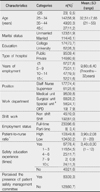Abstract
Purpose
This study was done to identify the factors affecting the perception of patient-safety-culture and the level of safety-care-activity among nurses in small-medium sized general hospitals.
Method
Data were collected during April and May 2011, from 241 nurses of five hospitals. A hospital survey questionnaire on patient-safety-culture and safety-care-activity was used. Collected data were analyzed using descriptive statistics, Pearson correlation, t-test, ANOVA, Scheffe test and multiple-regression.
Results
There were significant differences in the level of perception of patient-safety-culture according to the nurses' age, type of hospital, position, work department, and knowing whether there was a Patient-Safety committee in their hospitals. Nurses with higher perceived level of the patient-safety-culture performed more safety-care-activities. Factors influencing on the safety-care-activities were general patient safety, having had safety-education, patient-to-nurse ratio, employment status, and the level of reporting medical errors. These factors explained 22.9% of the safety-care-activity.
Conclusions
The study findings suggest that in order to improve the nurses' perceived level of patient-safety-culture and safety-care-activity, the hospitals need to establish patient-safety committees and communication systems, and openness to reporting medical errors are needed. Better work conditions to ensure appropriate work time, regulate patient-to-nurse ratio, and nursing education standards and criteria, are also required.
Figures and Tables
References
1. Agency for Healthcare Research and Quality. Hospital survey on patient culture (NO. 04-0041). AHRQ publication. 2004. Retrieved at April, 2010. from http://www.ahrq.gov/qual/patients afetyculture/hospsurvindex.htm.
2. Aspden P, Corrigan JM, Wolcott J, Erickson SM, editors. Patient safety: achieving a new standard for care. 2004. Washington, DC: National Academy Press.
3. Carmel MH, Kate LL. Nurses' and nursing assistants' perception of patient safety culture in nursing homes. Int J Qual Health Care. 2006. 18(4):281–286.
4. Choi JH, Lee KM, Lee MA. Relationship between hospital nurses' perceived patient safety culture and their safety care activities. J Korean Acad Fundam Nurs. 2010. 17(1):64–72.
5. Choi MH. Perception of patient safety culture and influencing the factors among hospital workers. 2010. Daegu: Keimyung University;Unpublished master's thesis.
6. Faul F, Erdfelder E, Buchner A, Lang A. Statistical power analyses using G*Power 3.1: tests for correlation and regression analyses. Behav Res Methods. 2009. 41:1149–1160.

7. Institute of Medicine. Crossing the quality chasm: a new health system for the 21st century. 2001. Washington, DC: National Academies Press.
8. Je WY. Hospital worker's perception of patient safety culture in a university hospital. 2007. Seoul: Sungkyunkwan University;Unpublished master's thesis.
9. Jeong J, Seo YJ, Nam EW. Factors affecting patient safety management activities at nursing divisions of two university hospital. Korean J Hosp Manage. 2006. 11(1):91–109.
10. Kim JE, Ahn KE, Yoon SH. Nurses perception of the hospital environment and communication process related to patient safety in Korea. J Korean Soc Med Inform. 2004. 10:suppl 1. 130–135.
11. Kim JE, Kang MA, Ahn KE, Sung YH. A survey of nurses perception of patient safety related to hospital culture and reports of medical errors. Clin Nurs Res. 2007. 13:169–179.
12. Kim JH. Analysis of the nursing interventions performed by nurses working in small-medium sized hospitals using Nursing Interventions Classification [NIC]. J Korean Acad Nurs Adm. 2007. 13(4):431–444.
13. Kim MA, Park KO, You SJ, Kim MJ, Kim ES. A survey of nursing activities in small and medium-size hospitals: reasons for turnover. J Korean Clin Nurs Res. 2009. 15(1):149–165.
14. Kim YE. Perceptions of patient safety culture of hospital nurses. 2009. Jeonju: Chonbuk University;Unpublished master's thesis.
15. Kim YM, Kil YK, Min J, Jung YY, Choi EK. Safety care. 2009. Seoul: Korean Nurses Association.
16. Kizer KW. Scheffler A, Zipperer MA, editors. Large system change and culture of safety. Enhancing patient safety and reducing errors in Health care. 1999. Chicago, IL: National Patient Safety Foundation.
17. Lee KH, Lee YS, Park HK, Rhu JO, Byun IS. The influences of the awareness of patient safety culture on safety care activities among operating room nurses. J Korean Clin Nurs Res. 2011. 17(2):204–214.
18. Korea Institute for Healthcare Accreditation. 2010 Healthcare accreditation standard (plan). 2010. Seoul: Ministry of Health & Welfare.
19. Lee KM. A study on the nurse's civil liability. 2001. Daegu: Yeungnam University;Unpublished master's thesis.
20. Lee YJ. Patient safety culture and management activities perceived by hospital nurses. 2011. Daejeon: Eulji University;Unpublished master's thesis.
21. Meterko M. Teamworks culture and patient satisfaction in hospitals. Med Care. 2004. 42(5):492–498.
22. Milligan F, Dennis S. Improving patient safety and incident reporting. Nurs Stand. 2004. 19(7):33–36.

23. Nam MH. The cognition level on the patient safety and safe nursing activities among hospital nurses in Busan. 2010. Busan: Inje University;Unpublished doctoral dissertation.
24. National Patient Safety Agency. Seven steps to patient safety: an overview guide for NHS staff. 2004. London: National Health Service.
25. Park HO. Medical evaluation, it should be helpful to nurses' empowerment. Korean Nurse. 2003. 46(4):248.
26. Park SJ. A study on hospital nurse's perception of patient safety culture and safety care activity. 2008. Busan: Dong-A University;Unpublished master's thesis.
27. Yang HY. A study on the effect of perception of hospital nurses toward the patient safety culture on the safety nursing activity-focusing on Suncheon Region. 2009. Suncheon: Suncheon National University;Unpublished master's thesis.
28. You SJ, Chang HS, Kim MK, Choi YK, Sung YH, Kim ES, Kwag WH. Study of utilization of nursing personnel by types of medical institutions. Clin Nurs Res. 2005. 13(1):157–172.




 PDF
PDF ePub
ePub Citation
Citation Print
Print








 XML Download
XML Download